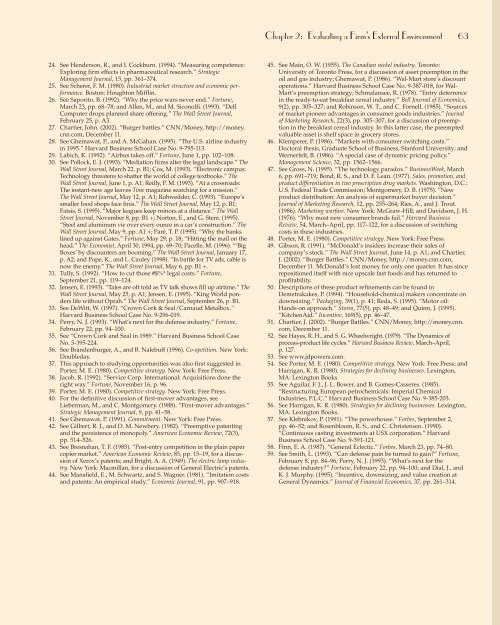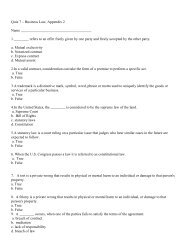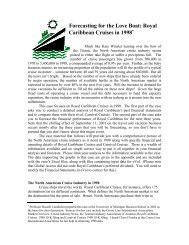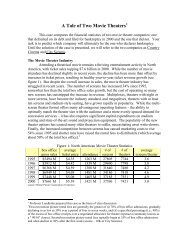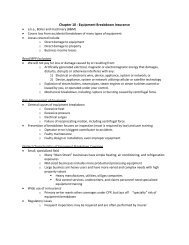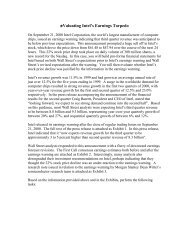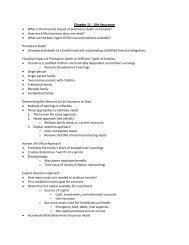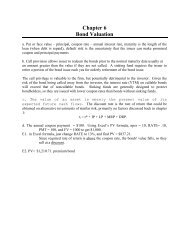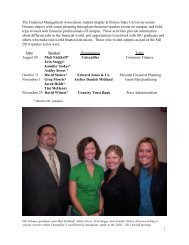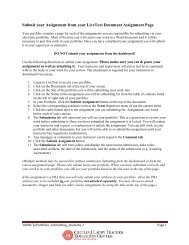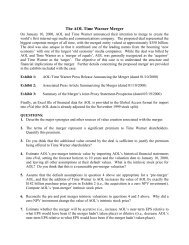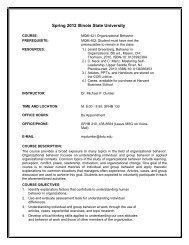Evaluating a Firm's External Environment - Illinois State University
Evaluating a Firm's External Environment - Illinois State University
Evaluating a Firm's External Environment - Illinois State University
You also want an ePaper? Increase the reach of your titles
YUMPU automatically turns print PDFs into web optimized ePapers that Google loves.
M02_BARN4586_03_SE_C02.qxd 7/1/09 7:34 AM Page 63<br />
Chapter 2: <strong>Evaluating</strong> a Firm’s <strong>External</strong> <strong>Environment</strong> 63<br />
24. See Henderson, R., and I. Cockburn. (1994). “Measuring competence:<br />
Exploring firm effects in pharmaceutical research.” Strategic<br />
Management Journal, 15, pp. 361–374.<br />
25. See Scherer, F. M. (1980). Industrial market structure and economic performance.<br />
Boston: Houghton Mifflin.<br />
26. See Saporito, B. (1992). “Why the price wars never end.” Fortune,<br />
March 23, pp. 68–78; and Allen, M., and M. Siconolfi. (1993). “Dell<br />
Computer drops planned share offering.” The Wall Street Journal,<br />
February 25, p. A3.<br />
27. Chartier, John. (2002). “Burger battles.” CNN/Money, http://money.<br />
cnn.com, December 11.<br />
28. See Ghemawat, P., and A. McGahan. (1995). “The U.S. airline industry<br />
in 1995.” Harvard Business School Case No. 9-795-113.<br />
29. Labich, K. (1992). “Airbus takes off.” Fortune, June 1, pp. 102–108.<br />
30. See Pollock, E. J. (1993). “Mediation firms alter the legal landscape.” The<br />
Wall Street Journal, March 22, p. B1; Cox, M. (1993). “Electronic campus:<br />
Technology threatens to shatter the world of college textbooks.” The<br />
Wall Street Journal, June 1, p. A1; Reilly, P. M. (1993). “At a crossroads:<br />
The instant-new age leaves Time magazine searching for a mission.”<br />
The Wall Street Journal, May 12, p. A1; Rohwedder, C. (1993). “Europe’s<br />
smaller food shops face finis.” The Wall Street Journal, May 12, p. B1;<br />
Fatsis, S. (1995). “Major leagues keep minors at a distance.” The Wall<br />
Street Journal, November 8, pp. B1 +; Norton, E., and G. Stem. (1995).<br />
“Steel and aluminum vie over every ounce in a car’s construction.” The<br />
Wall Street Journal, May 9, pp. A1 +; Paré, T. P. (1995). “Why the banks<br />
lined up against Gates.” Fortune, May 29, p. 18; “Hitting the mail on the<br />
head.” The Economist, April 30, 1994, pp. 69–70; Pacelle, M. (1996). “‘Big<br />
Boxes’ by discounters are booming.” The Wall Street Journal, January 17,<br />
p. A2; and Pope, K., and L. Cauley (1998). “In battle for TV ads, cable is<br />
now the enemy.” The Wall Street Journal, May 6, pp. B1 +.<br />
31. Tully, S. (1992). “How to cut those #$%* legal costs.” Fortune,<br />
September 21, pp. 119–124.<br />
32. Jensen, E. (1993). “Tales are oft told as TV talk shows fill up airtime.” The<br />
Wall Street Journal, May 25, p. A1; Jensen, E. (1995). “King World ponders<br />
life without Oprah.” The Wall Street Journal, September 26, p. B1.<br />
33. See DeWitt, W. (1997). “Crown Cork & Seal/Carnaud Metalbox.”<br />
Harvard Business School Case No. 9-296-019.<br />
34. Perry, N. J. (1993). “What’s next for the defense industry.” Fortune,<br />
February 22, pp. 94–100.<br />
35. See “Crown Cork and Seal in 1989.” Harvard Business School Case<br />
No. 5-395-224.<br />
36. See Brandenburger, A., and B. Nalebuff (1996). Co-opetition. New York:<br />
Doubleday.<br />
37. This approach to studying opportunities was also first suggested in<br />
Porter, M. E. (1980). Competitive strategy. New York: Free Press.<br />
38. Jacob, R. (1992). “Service Corp. International: Acquisitions done the<br />
right way.” Fortune, November 16, p. 96.<br />
39. Porter, M. E. (1980). Competitive strategy. New York: Free Press.<br />
40. For the definitive discussion of first-mover advantages, see<br />
Lieberman, M., and C. Montgomery. (1988). “First-mover advantages.”<br />
Strategic Management Journal, 9, pp. 41–58.<br />
41. See Ghemawat, P. (1991). Commitment. New York: Free Press.<br />
42. See Gilbert, R. J., and D. M. Newbery. (1982). “Preemptive patenting<br />
and the persistence of monopoly.” American Economic Review, 72(3),<br />
pp. 514–526.<br />
43. See Bresnahan, T. F. (1985). “Post-entry competition in the plain paper<br />
copier market.” American Economic Review, 85, pp. 15–19, for a discussion<br />
of Xerox’s patents; and Bright, A. A. (1949). The electric lamp industry.<br />
New York: Macmillan, for a discussion of General Electric’s patents.<br />
44. See Mansfield, E., M. Schwartz, and S. Wagner. (1981). “Imitation costs<br />
and patents: An empirical study.” Economic Journal, 91, pp. 907–918.<br />
45. See Main, O. W. (1955). The Canadian nickel industry. Toronto:<br />
<strong>University</strong> of Toronto Press, for a discussion of asset preemption in the<br />
oil and gas industry; Ghemawat, P. (1986). “Wal-Mart store’s discount<br />
operations.” Harvard Business School Case No. 9-387-018, for Wal-<br />
Mart’s preemption strategy; Schmalansee, R. (1978). “Entry deterrence<br />
in the ready-to-eat breakfast cereal industry.” Bell Journal of Economics,<br />
9(2), pp. 305–327; and Robinson, W. T., and C. Fornell. (1985). “Sources<br />
of market pioneer advantages in consumer goods industries.” Journal<br />
of Marketing Research, 22(3), pp. 305–307, for a discussion of preemption<br />
in the breakfast cereal industry. In this latter case, the preempted<br />
valuable asset is shelf space in grocery stores.<br />
46. Klemperer, P. (1986). “Markets with consumer switching costs.”<br />
Doctoral thesis, Graduate School of Business, Stanford <strong>University</strong>; and<br />
Wernerfelt, B. (1986). “A special case of dynamic pricing policy.”<br />
Management Science, 32, pp. 1562–1566.<br />
47. See Gross, N. (1995). “The technology paradox.” BusinessWeek, March<br />
6, pp. 691–719; Bond, R. S., and D. F. Lean. (1977). Sales, promotion, and<br />
product differentiation in two prescription drug markets. Washington, D.C.:<br />
U.S. Federal Trade Commission; Montgomery, D. B. (1975). “New<br />
product distribution: An analysis of supermarket buyer decision.”<br />
Journal of Marketing Research, 12, pp. 255–264; Ries, A., and J. Trout.<br />
(1986). Marketing warfare. New York: McGraw-Hill; and Davidson, J. H.<br />
(1976). “Why most new consumer brands fail.” Harvard Business<br />
Review, 54, March–April, pp. 117–122, for a discussion of switching<br />
costs in these industries.<br />
48. Porter, M. E. (1980). Competitive strategy. New York: Free Press.<br />
49. Gibson, R. (1991). “McDonald’s insiders increase their sales of<br />
company’s stock.” The Wall Street Journal, June 14, p. A1; and Chartier,<br />
J. (2002). “Burger Battles.” CNN/Money, http://money.cnn.com,<br />
December 11. McDonald’s lost money for only one quarter. It has since<br />
repositioned itself with nice upscale fast foods and has returned to<br />
profitability.<br />
50. Descriptions of these product refinements can be found in<br />
Demetrakakes, P. (1994). “Household-chemical makers concentrate on<br />
downsizing.” Packaging, 39(1), p. 41; Reda, S. (1995). “Motor oil:<br />
Hands-on approach.” Stores, 77(5), pp. 48–49; and Quinn, J. (1995).<br />
“KitchenAid.” Incentive, 169(5), pp. 46–47.<br />
51. Chartier, J. (2002). “Burger Battles.” CNN/Money, http://money.cnn.<br />
com, December 11.<br />
52. See Hayes, R. H., and S. G. Wheelwright. (1979). “The Dynamics of<br />
process-product life cycles.” Harvard Business Review, March–April,<br />
p. 127.<br />
53. See www.jdpowers.com.<br />
54. See Porter, M. E. (1980). Competitive strategy. New York: Free Press; and<br />
Harrigan, K. R. (1980). Strategies for declining businesses. Lexington,<br />
MA: Lexington Books.<br />
55. See Aguilar, F. J., J. L. Bower, and B. Gomes-Casseres. (1985).<br />
“Restructuring European petrochemicals: Imperial Chemical<br />
Industries, P.L.C.” Harvard Business School Case No. 9-385-203.<br />
56. See Harrigan, K. R. (1980). Strategies for declining businesses. Lexington,<br />
MA: Lexington Books.<br />
57. See Klebnikov, P. (1991). “The powerhouse.” Forbes, September 2,<br />
pp. 46–52; and Rosenbloom, R. S., and C. Christensen. (1990).<br />
“Continuous casting investments at USX corporation.” Harvard<br />
Business School Case No. 9-391-121.<br />
58. Finn, E. A. (1987). “General Eclectic.” Forbes, March 23, pp. 74–80.<br />
59. See Smith, L. (1993). “Can defense pain be turned to gain?” Fortune,<br />
February 8, pp. 84–96; Perry, N. J. (1993). “What’s next for the<br />
defense industry?” Fortune, February 22, pp. 94–100; and Dial, J., and<br />
K. J. Murphy. (1995). “Incentive, downsizing, and value creation at<br />
General Dynamics.” Journal of Financial Economics, 37, pp. 261–314.


